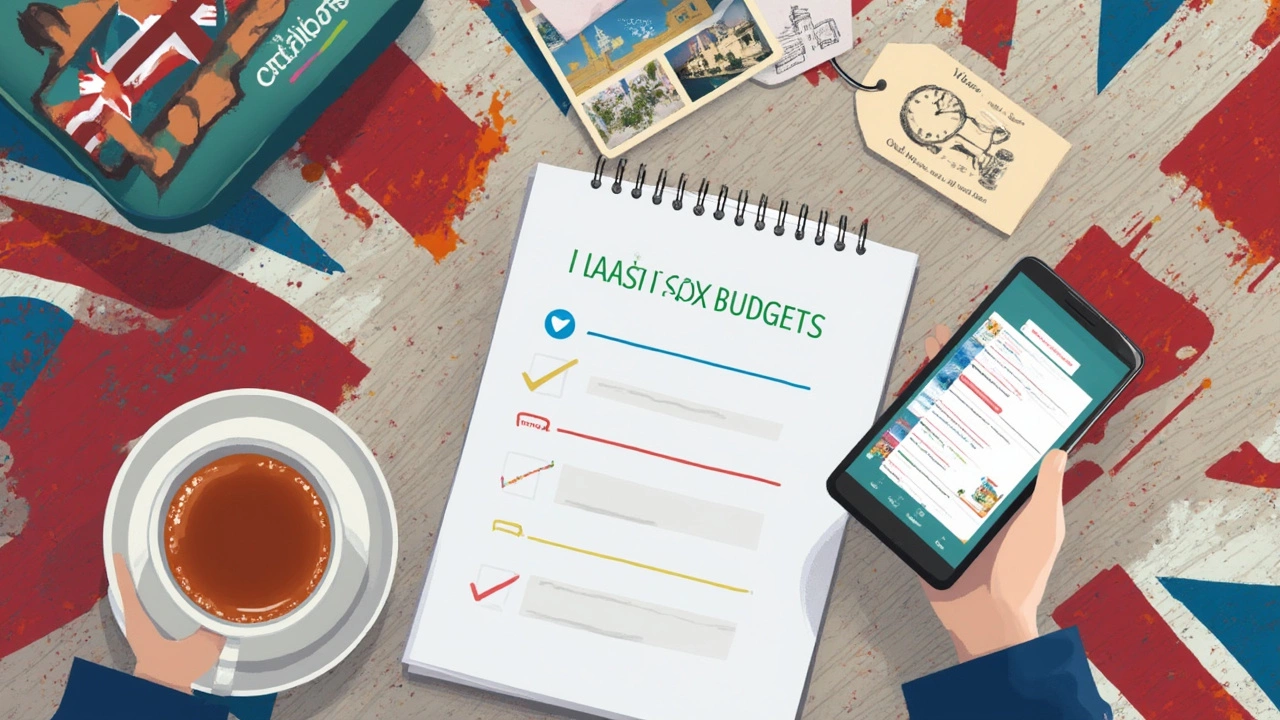Ever tried to lose track of where your money goes each month? Nobody does it on purpose, but without a clear plan, cash disappears fast. That’s why every solid budget comes down to just five main things. Nail these, and you’ll know exactly where your cash is going, what you can actually afford, and how to hit your money goals.
Most folks think budgeting means cutting out fun stuff or getting scolded by a spreadsheet. Actually, it’s just about taking control—no shame, no fancy calculators, no lectures. You need to spot every dollar that comes in, figure out what absolutely has to be paid, see which expenses are flexible, remember to pay yourself, and chip away at debt if it’s hanging around. Mess up any one of these, and the whole budget can start to wobble.
Ready for your money to finally make sense? Let’s start with the first and most important piece: your income.
- Income: Counting Every Dollar
- Fixed Expenses: What You Just Can't Skip
- Variable Expenses: The Flexible Stuff
- Savings: Paying Your Future Self
- Debt Payments: Chipping Away at What You Owe
Income: Counting Every Dollar
If you don’t know how much money is coming in, your whole budget is just guesswork. You’d be surprised how many people only have a ballpark idea of their paychecks or forget about extra income here and there. Getting this right is non-negotiable—it’s the foundation for everything else.
When you’re doing your budget, you want to add up every single source of income. That means your regular paycheck after taxes, side gigs, freelance work, child support, tips, rental income—literally any cash you can count on. Don’t use the before-tax numbers (gross income); use what actually lands in your bank (net income). This is what you’ve really got to spend or save at the end of the month.
Here’s a useful way to lay it out:
| Income Source | Monthly Amount ($) |
|---|---|
| Main Job (Net) | 3,200 |
| Part-Time Gig | 450 |
| Freelance Project | 300 |
| Child Support | 400 |
| Total Income | 4,350 |
Pro tip: If your income changes (like if you work hourly or on commissions), use the lowest amount you usually earn in a slow month. That way, your budget will work even when cash flow is tight. Anything extra can be set aside for savings or tackling debt.
One more thing—double check to include things that only come every few months or seasonally. Tax refunds, bonuses, or even holiday pay can all add up, so don’t let those slip through the cracks. Knowing your real income means you’re never trying to stretch money that just isn’t there.
Fixed Expenses: What You Just Can't Skip
This is the stuff you have to pay, no matter what. Monthly rent, car payments, insurance, and mortgage bills fall right here. These aren’t optional or flexible—they hit your account like clockwork.
When you build a budget, you want these fixed expenses listed out first. Forgetting even one can seriously mess up your plan. Here’s some real talk: most Americans pay about 30% of their income on housing alone, based on data from the U.S. Bureau of Labor Statistics. That’s why rent or home payments usually eat up the biggest chunk of this category.
- Rent or mortgage
- Car payments
- Insurance (health, car, renters, etc.)
- Loan payments (student loans, personal loans)
- Childcare
- Membership fees (like gym or streaming if you have year-long contracts)
Here’s a quick look at how the average monthly fixed expenses might stack up, using recent numbers:
| Category | Typical Monthly Cost (US, 2024) |
|---|---|
| Housing (Rent/Mortgage) | $1,350 |
| Car Payment | $730 |
| Health Insurance | $535 |
| Student Loan Payment | $400 |
| Childcare | $850 |
Not all of these will hit your wallet, but it’s worth looking at each and deciding what applies. These payments rarely change month to month, so getting this number right keeps your budget way more predictable. If your fixed expenses are eating more than half your income, it might be time to rethink things, like moving to a cheaper place or refinancing a loan. The goal isn’t to panic—it’s to get real about what’s non-negotiable so you can manage your money with less stress.

Variable Expenses: The Flexible Stuff
Here’s where things get interesting—variable expenses are all the stuff you spend money on that isn’t locked in. We’re talking about groceries, eating out, gas, home supplies, haircuts, coffee runs, and all those one-off shopping sprees. Unlike your rent or car payment, these numbers can change every single month.
Most people don’t realize how much wiggle room variable expenses give you in your budget. According to a 2023 survey from the Bureau of Labor Statistics, the average U.S. household spent about $7,300 a year on food alone. That’s a ton of potential savings if you just track and tweak a bit each month.
To get a handle on these expenses, start with a list. Write down everything you typically buy that isn’t a regular bill. Add things like streaming subscriptions or hobbies—yes, those count as variable too if they’re not required payments.
- Groceries and snacks
- Restaurants and takeout
- Fuel or transportation
- Personal care and haircuts
- Entertainment (movies, streaming, bowling night)
- Shopping (clothes, gifts, electronics)
The trick here isn’t to cut everything fun. It’s to pick an average monthly amount you can live with. If you overspend one week on takeout, maybe grab less expensive groceries the next. The real power in tracking variable expenses? You can quickly adjust when things get tight—say, gas prices spike or there’s an unexpected party coming up.
One helpful way to stay on track is to use the envelope method: set aside cash for each category. It’s old school, but it works. If you’re more digital, apps like Mint or You Need a Budget let you set flexible limits so you can see if you’re close to hitting your max.
"A budget is telling your money where to go instead of wondering where it went." – Dave Ramsey
Bottom line? These flexible expenses can sneak up on anyone. Stay aware, and use them to your advantage. When push comes to shove, variable expenses are where you make adjustments to hit your savings or pay down debt faster.
Savings: Paying Your Future Self
Savings usually gets the short end of the stick when it comes to monthly budgets. Everybody knows they should save, but it’s easy to push it down the list after rent, groceries, and bills. The thing is, building up your savings is really just making sure you’re covered when life throws a curveball. Even putting away a small amount each month can make a massive difference over time.
The general rule that financial advisors throw around is to save at least 20% of your take-home pay. That’s based on the 50/30/20 rule: 50% for needs, 30% for wants, and 20% for savings and debt payments. If 20% seems steep, start lower—consistency is way more important than the dollar amount when you’re getting started.
Why save? Emergencies, broken cars, surprise medical bills, or even happy stuff like a last-minute road trip all cost money. And nobody wants to get smacked with a bill they didn’t see coming. According to a 2024 Federal Reserve survey, nearly 37% of adults said they’d cover a $400 emergency expense using cash or savings, up from 32% in 2022. That means a lot of folks still aren’t ready for life’s ups and downs.
"Do not save what is left after spending, but spend what is left after saving."—Warren Buffett
Here’s a breakdown of some common types of savings goals:
- Emergency fund (aim for 3–6 months of expenses if you can swing it)
- Big future purchases (car, down payment, new tech, vacation)
- Retirement (IRAs, 401(k)s—get that employer match if it’s on offer)
- Short-term fun (concert tickets, new gear, hobbies)
Check out how even small, regular deposits add up down the line:
| Monthly Savings | After 1 Year | 5 Years | 10 Years |
|---|---|---|---|
| $50 | $600 | $3,000 | $6,000 |
| $100 | $1,200 | $6,000 | $12,000 |
| $250 | $3,000 | $15,000 | $30,000 |
Try automating savings so the money leaves your checking account as soon as your paycheck lands—out of sight, out of mind. Treating savings like a recurring budget item (instead of an afterthought) makes it a whole lot easier to stick with.

Debt Payments: Chipping Away at What You Owe
If you’ve got debt, like student loans, credit cards, or car payments, you can’t just ignore it and hope it goes away. Debt sucks money from your budget every month, whether you like it or not. Even if you only pay the minimum, interest piles up and makes those bills stick around even longer.
On average, U.S. households carry about $7,000 in credit card debt alone, not counting mortgages or student loans. That debt costs real money in interest, with credit cards often charging over 20%. If you don’t add debt payments to your budget, you’ll always feel like you’re treading water.
"Getting out of debt isn’t just about throwing extra cash at your balances—it starts with knowing exactly what you owe and making consistent payments every month." — Dave Ramsey
Here’s a simple way to tackle debt payments in your budget:
- List every debt: Write down each loan and credit card, plus their minimum monthly payments and interest rates.
- Figure out what you can actually pay: Always pay the minimum, but add extra if you can. Focus on the highest-interest debt first if you want to pay less in the long run (this is called the avalanche method).
- Put it on autopay: Set up automatic payments so you don’t miss a due date—one late payment can ding your credit score.
Treat debt payments like a monthly bill that’s non-negotiable. It’s just as important as rent, groceries, or your phone plan. If you get a tax refund or a bonus at work, consider throwing at least part of it at your debt pile to get rid of it faster.
| Type of Debt | Average Interest Rate (2025) | U.S. Household Average Balance |
|---|---|---|
| Credit Card | 21.5% | $7,000 |
| Auto Loan | 7.2% | $28,000 |
| Student Loan | 5.9% | $32,000 |
Chipping away at debt each month doesn’t just shrink what you owe. It also gives you less stress, better credit, and eventually, more cash for the stuff you actually want to do. Make space for debt payments in your budget, and you start to take real control of your money story.

